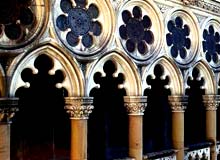 Like all other aspects, colonization of Indian also had an impact onarchitecture style. With colonization, a new chapter in Indian architecturebegan. The Dutch, Portuguese and the French made their presence felt through their buildings but it was the English who had a lasting impact onarchitecture. In the beginning of the colonial rule there were attempts at creating authority through classical prototypes. In its later phase the colonial architecture culminated into what is called the Indo-Saracenic architecture.
Like all other aspects, colonization of Indian also had an impact onarchitecture style. With colonization, a new chapter in Indian architecturebegan. The Dutch, Portuguese and the French made their presence felt through their buildings but it was the English who had a lasting impact onarchitecture. In the beginning of the colonial rule there were attempts at creating authority through classical prototypes. In its later phase the colonial architecture culminated into what is called the Indo-Saracenic architecture.The Indo-Saracenic architecture combined the features of Hindu, Islamic and western elements. The colonial architecture exhibited itself through institutional, civic and utilitarian buildings such as post offices, railway stations, rest houses and government buildings. Such buildings began to be built in large numbers over the whole empire. Colonial architecture in India followed developments not only from metropolis but also took inspiration from existing architecture in India.
From the mid nineteenth century it became a norm for the Anglo-Indian church builders to follow the model set by the revivers of the many combinations of Gothic in England. In many cases imperialism was the sole guiding force rather than practicality. On many occasions heavier styles than Gothic were employed. This can be seen in the Mutiny Memorial Church at Kanpur and the last garrison church in New Delhi.
The Italian Gothic was seen to be well adapted to conditions in India. The architecture style recommended by Sir Gilbert Scott for Bombay University proved crucial in making the colonial architecture look more 'Indian'. Perhaps this was the beginning of a truly imperial style that reached its apex at New Delhi. The great public building campaign launched in Bombay in the second half of the nineteenth also resulted into great development of colonial architecture. In this phase Sir Gilbert Scott's buildings were significant products. Other remarkable landmarks produced during this phase were William Emerson's Crawford Market, the Bombay high court and the Victoria terminus (now Shivaji terminus).
The Victoria Terminus, once the headquarters of the Great Indian Peninsular Railway, was the culminating masterpiece of the phase. It was increasingly hybrid in style. The Classical and Baroque style furthered the innovation in architecture. Its best exponent was Walter Carnville's Calcutta General Post Office. The innovation in colonial architecture did not stop here; in Victoria Memorial, William Emerson tried to emulate the Taj Mahal in material if not in form. This was an indication of 'Indo-Saracenic' hybridization and was being increasingly employed at different places like St. John's College, Agra and the Madras High Court, Madras.

1 comment:
very impressive article do not miss my blogging tips
Post a Comment